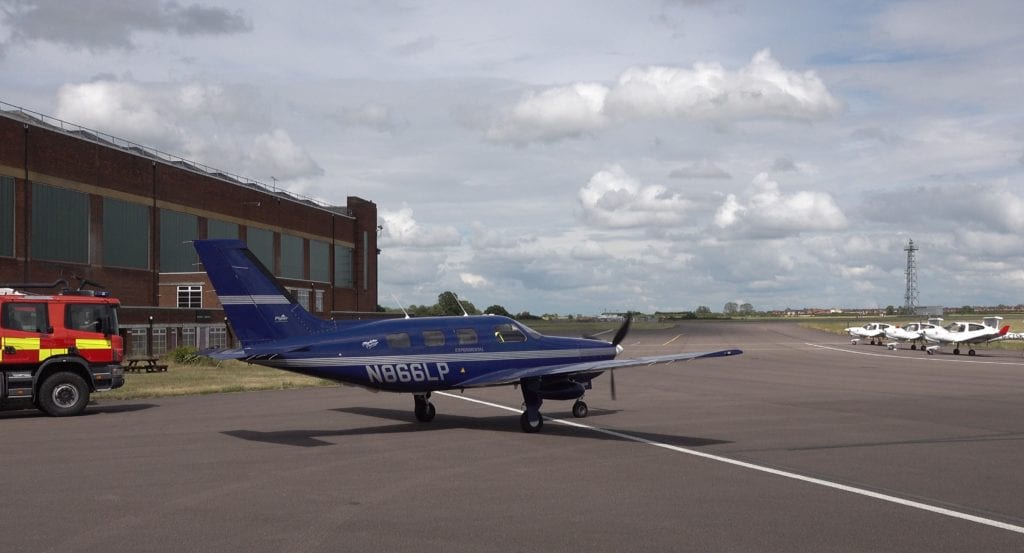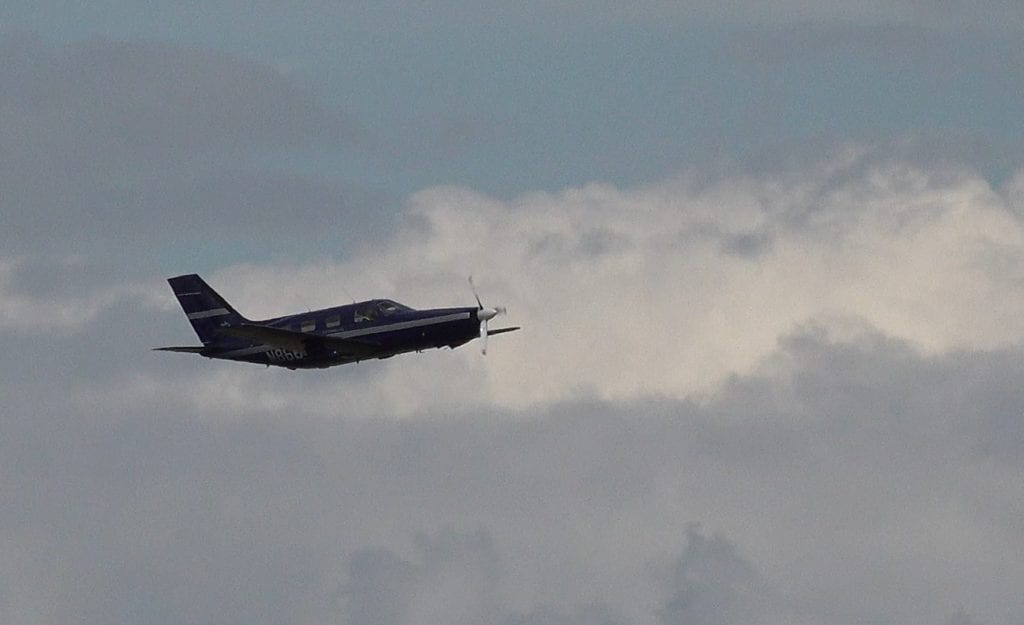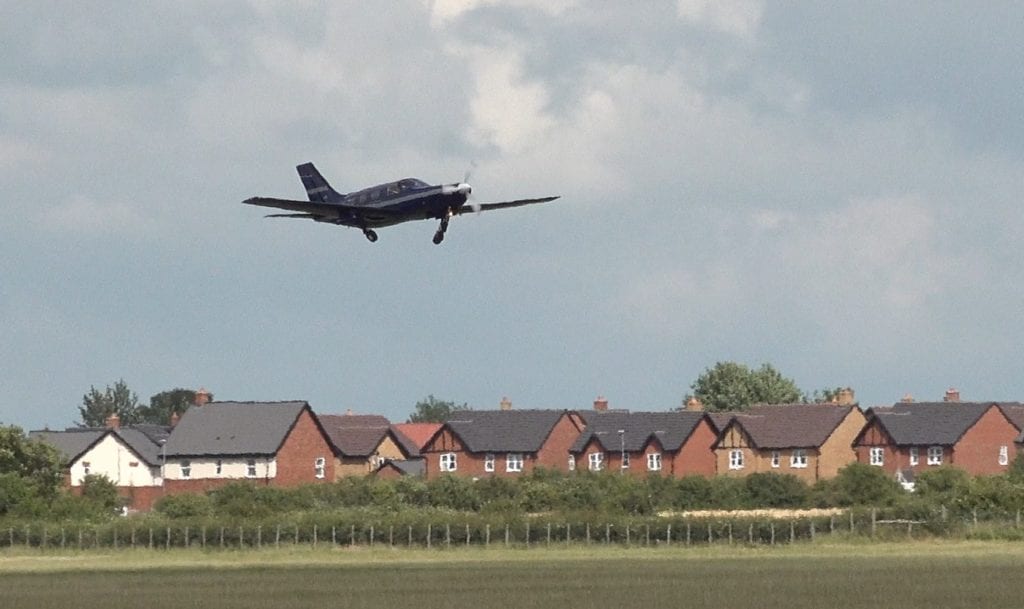
ZeroAvia's modified Piper Mirage six-seater turboprop is the first commercial-scale battery electric powered aircraft to complete a successful flight test. Photo: ZeroAvia
ZeroAvia recently completed the first phase of test flights for the U.K.'s first ever electric-powered commercial-scale aircraft, as the Silicon Valley startup works toward its initial goal for the development of a certifiable zero emissions hydrogen-electric turboprop by 2023.
The series of 10+ test flights, completed beginning June 23 at Cranfield University’s airport, used a Piper Malibu Mirage turboprop modified with a 300-kilowatt (kW) battery electric power system along with a customized cockpit display and computer. Each flight is part of Project HyFlyer, a U.K. government-industry funded program launched last year to demonstrate how medium range small passenger aircraft can be decarbonized.
ZeroAvia CEO Val Miftakhov told Avionics International that the goal with the first flight was to match the performance of the aircraft’s stock engine, a six cylinder Lycoming 540-AE2A with a 350 horsepower rating – or the equivalence of 260 kW.
“Cranfield is a sea level airport, and we were at 1,000 feet [mean sea level] MSL, in a pattern, so these are mostly sea level numbers. We recorded the most economic cruise from the flight occurring at 2,000-RPM prop speed, 90 kts indicated and that was with 75 kW of consumption. That works out to about 800 or so watt hours per nautical mile, which is pretty good, given that it’s comparable with what my Tesla Model S does at that speed,” Miftakhov said.
Over the course of two weeks, the ZeroAvia team completed multiple test flights, while capturing data about the temperatures, power flows and torque characteristics of the aircraft at takeoff, cruise and landing. Miftakhov said that the biggest overall challenges in preparing for and operating the flights were the thermal management of the electric motors, inverters and heat exchangers.
On the traditional jet fuel powered set up for their Piper Mirage, incoming air usually flows into the air box off the prop through two air inlets on the nose of the aircraft. It then flows around the cylinders and gets diverted into one of two turbocharger intercoolers to help decrease the temperature of the air entering the intake manifold. Airflow then continues down through the cowling and flows out through exhaust points at the bottom left and right sides of the aircraft.
Under the battery-powered system, the intercoolers were replaced with radiators that acted as heat exchangers for the electric motors and power inverters. An ideal location for the radiators would have been the frontal portion of the air box, which was not available because that space was needed for thermally managing airflow around the ZeroAvia fuel cell system design.
The pilot performing the flight test was using a fully electronically managed power system that provides readouts indicating whether the aircraft is approaching a condition that exceeds the recommended operating parameters. Through a fly-by-wire style system, an electronic interface module takes the mechanical displacement of pilot inputs on the throttle and converts that into an electronic signal for the customized battery electric navigation computer.
“As the computer is deciding what to do with the pilot inputs, it is checking the temperature of the motors and inverters as well as the remaining voltage supply level of the battery,” Mifthakov said. “If the computer detects an exceedance on any of those parameters, it then makes a decision on what to do with that throttle input, and how to de-rate it for example based on what’s available. That will then generate associated messages on the pilot’s display.”
ZeroAvia and its partners for Project HyFlyer are now preparing for the next round of flight-testing using the hydrogen electric powertrain that they ultimately want to use for zero emissions passenger carrying aircraft. In that system, the power inverters and electric motors still drive the propeller, however the electricity is provided by the hydrogen fuel cell system in place of the battery.
“Instead of getting electricity from the battery we get it from the hydrogen fuel cell system, which takes hydrogen from the tanks, combines it with oxygen from the air, and produces electricity,” Mifthakhov said, adding that the biggest cost savings for their preference of hydrogen to battery power is the limited lifespan of batteries compared to the life of the aircraft.
Additionally, the energy density of the hydrogen electric system is “five times better than battery power,” as the weight of the hydrogen fuel cell system is significantly lower, according to Mifthakov.
“A lot of economic comparisons of electrified power trains just use the energy cost and do not talk about the additional operating costs that come in with the use of the battery. On aircraft that use jet fuel, the fuel tanks will last for the duration of the aircraft. Similarly with a hydrogen fuel cell system, your tanks last as long as the aircraft. But for batteries, cycling adds a significant cost element, because a typical high-energy battery can only go for 1,000 to 2,000 cycles. And if you try to operate that for a regional scheduled flight service, where you could have up to eight flights a day or more, it’s much more expensive,” he said.
ZeroAvia is planning its first test flight using their hydrogen electric system within the next several weeks. Project HyFlyer’s ultimate goal is a 300-nautical mile flight in the hydrogen-powered Mirage taking off from the Orkney Islands in Scotland.
While the 2023 goal is a 19-passenger Twin Otter capable of 500-mile regional flights, their next goal will target larger regional turboprops like Bombardier’s Dash-8 or the ATR 500 series by the end of the decade. Mifthakov said the team believes it can achieving operating costs that are half of what are required for a jet fuel powered Twin Otter.
"electric" - Google News
July 08, 2020 at 02:26AM
https://ift.tt/2Zar3P7
ZeroAvia Completes First Phase of Test Flights On Path to Hydrogen-Electric Turboprop - Aviation Today
"electric" - Google News
https://ift.tt/2yk35WT
https://ift.tt/2YsSbsy
Bagikan Berita Ini

















0 Response to "ZeroAvia Completes First Phase of Test Flights On Path to Hydrogen-Electric Turboprop - Aviation Today"
Post a Comment